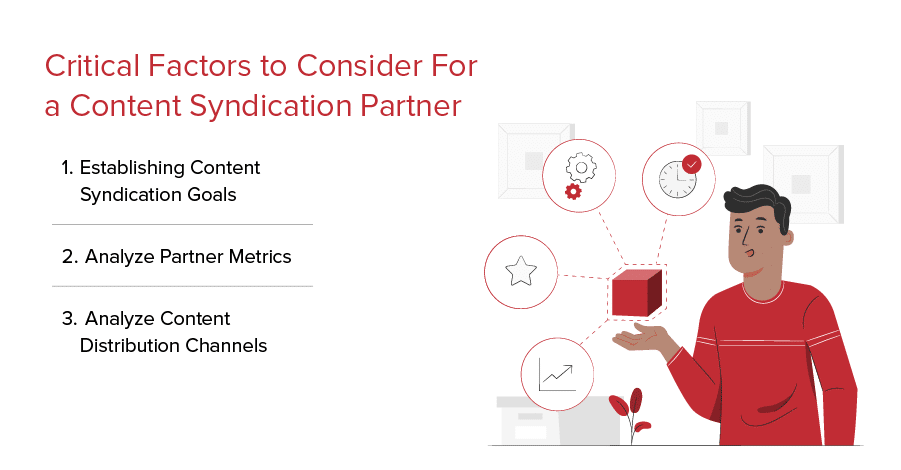Table of Contents
Introduction
For the commoners, content syndication is a marketing methodology. It allows businesses to take their content in front of their targeted audience. The content can be an eBook, a blog post, a whitepaper, or a well-produced video.
For B2B sales and marketing professionals, content syndication is the art of attracting the right kind of leads. It is educating, engaging, and qualifying leads about your products/services even before their first visit to your product page or website. Content syndication as an industry is expected to grow from US$4.7 Billion in 2022 to a revised size of US$5.9 Billion by 2030. It highlights the growing need for content syndication among modern businesses. For businesses, content syndication is integral to their overall content marketing strategy.
Some of the Noteworthy Benefits of Content Syndication
Content syndication through websites with high Domain Authority/Page Authority (DA/PA) helps marketers take their content beyond their websites and social media streams. It helps them grow their reach, generate traffic for the website, and create brand awareness.
Publishing content on authoritative and reputable websites increases your brand authority by establishing your brand as a thought leader in your space.
Content syndication has been proven to generate leads from a broader audience base. It allows you to engage with an audience interested in your product/service through your content and consequently drive them to your website, where you capture them as a lead through call-to-action buttons or lead capture forms.
Publishing content on websites with high DA/PA allows you to create backlinks for your website, which are critical in improving your SEO rankings. This results in improved search engine rankings and, consequently, increased visibility for your brand.
With content syndication offering such significant benefits, businesses are increasing including it in their overall marketing plans.
If you, too are considering having content syndication as part of your content marketing plan, here are some of the best practices and strategies to help you get started.
Understand Your Target Audience and Their Needs
Even before you start creating content, you need to know the audience for whom you will be creating content. This will help identify the content type, the topics, and the channels to explore for your content syndication process. It’s always advised to be as specific as possible about your audience. Analyzing your existing customer base is a good and effective way to do so. Using your current customer data, you can segregate your audiences based on their demographics, interests, buying pattern, and buying stages in the sales funnel. This will make it easier for you to create content targeting each customer base at different stages of the sales funnel.
Identifying High-Performing Content
Identifying high-performing content for content syndication is all about making an informed decision using all the metrics and factors available on your content. Here are some easy steps to help you identify high-performing content for your content syndication program:
Always do an extensive content audit to determine high-performing content with respect to conversion rates and engagement. Some tools that can help you do a comprehensive content audit include SEMRush or Ahrefs.
Use your website’s analytics to identify the best-performing content pieces you have created recently. You can use data around the highest engagement, conversions, or traffic. Some other valuable metrics include time on page, page views, bounce rate, conversion rates, and social media shares.
Use your website’s analytics to identify the best-performing content pieces you have created recently. You can use data around the highest engagement, conversions, or traffic. Some other valuable metrics include time on page, page views, bounce rate, conversion rates, and social media shares.
While these are just a few of the vital steps that will help you identify your best-performing content, you can do your analysis by revisiting the best-performing content for you, analyzing your audience, and even the channel where you will be publishing your content.
Finding the Right Content Syndication Partner
While content syndication partners are aplenty in the market, only some people offering the service will be the right fit for you. You need to find the content syndication partner that will help you achieve your business goals most efficiently.
Here are some of the critical factors to consider when looking for a content syndication partner.
You must predefine the content you want to syndicate, the channels you want to explore, and the audience you want to target. These are just some fundamental goals you must establish when looking for a content syndication partner.
Just as you would do for your website, do a thorough analysis of your potential partner’s metrics, such as their engagement, website traffic, and social media reach. This will ensure their audiences align with your target audience and even the content type you want to syndicate.
You must review the channels your partner will leverage for content distribution. These channels could be their email database, social media, and other content distribution networks.
These are some of the steps that will make it easy for you to find the right content syndication partner. The key here is to analyze every potential partner thoroughly and join hands with the partner that best aligns with your business and content goals.
Conclusion
To sum up, content syndication best practices and strategies are as much about high-quality content as they are about finding the right partners and channels. So, while your focus certainly should be on the quality of content, you need to be very careful about finding the right partner and channels and have a close eye on the performance of your content. Do not be afraid to tweak or optimize your content strategy as and when you go. And if you need a partner to help you get started with your content syndication program, you can always write to us at [email protected], and we will help you get started with the right content, suitable channels, and valuable insights.
Frequently Asked Questions
A third-party website republishing web-based content is known as content syndication. Any type of digital content, including blog posts, articles, infographics, videos, and more, can be syndicated. Consider it a trade-like arrangement. The independent website receives relevant, free content.
In order to reach a larger audience and increase your leads, B2B content syndication involves distributing content across third-party channels or platforms. The strategic republishing of your content in multiple locations is the essence of content syndication.
This can help SEO while also generating valuable traffic. Syndicated content should be shared online. Sharing a link to your content on social media after it has been published on a third-party platform is a great way to draw readers.
The process of distributing your content to reach your target audience through a variety of channels is known as content syndication. It resembles content marketing and sales prospecting in many ways. The majority of people turn to content syndication to find qualified marketing leads (MQLs) for their sales teams.




